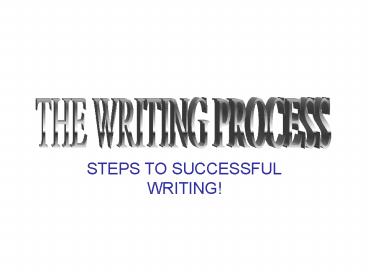STEPS TO SUCCESSFUL WRITING! - PowerPoint PPT Presentation
1 / 23
Title:
STEPS TO SUCCESSFUL WRITING!
Description:
STEPS TO SUCCESSFUL WRITING! Writing is a process. The purpose of writing is to communicate something to the reader. Writing gives your thoughts substance and form. – PowerPoint PPT presentation
Number of Views:509
Avg rating:3.0/5.0
Title: STEPS TO SUCCESSFUL WRITING!
1
THE WRITING PROCESS
- STEPS TO SUCCESSFUL WRITING!
2
The writing process consists of strategies that
will help you proceed from idea or purpose to the
final statement.
3
- Writing is a process.
- The purpose of writing is to communicate
something to the reader. - Writing gives your thoughts substance and form.
- Anyone can write.
- Successful writing does not just happen.
- Organization is the key.
- Writing begins before the pen hits the paper.
4
THE WRITING PROCESS
- Prewriting
- Drafting
- Revising
- Editing
- Finished Product
5
- The
- Prewriting
- Process
6
Prewriting is anything you do before you write a
draft of your document
Prewriting includes thinking, taking notes,
talking to people, gathering information, developi
ng ideas, organizing, researching, choosing a
topic
7
Prewriting can take two forms
You may be given no guidelines at all other than
to write. Or, you may be assigned a topic to
write about. Either way, you must prewrite
for good writing to occur.
If no guidelines are given, prewriting will help
you choose a topic that you are comfortable
writing about. If the topic is already assigned,
you can skip this part. But you will need to use
the prewriting time to organize your thoughts and
ideas Locate your subject Narrow your
topic Choose your controlling idea Generate
details to support your idea Formulate your
conclusion
8
Prewriting Techniques
- Freewriting/imagestreaming
- Brainstorming/making a jotlist
- Clustering/mapping/webbing
- Asking questions
- Journaling
- Outlining
- Researching/developing ideas from reading
- Interviewing outside experts
- Using graphic organizers
- Using the pentad method
9
- Prewriting is the most critical
- step to writing.
- Prewriting provides the direction, and the
organization to your writing.
10
DRAFTING
11
WRITING YOUR ROUGH DRAFT
Drafting occurs when you put your ideas into
sentences and paragraphs. You are concentrating
on getting your ideas down on paper. You are
trying to explain and support your ideas fully,
and to make sure you connect your thoughts. A
draft is writer-centeredthat means it is you
telling yourself what you know about the
topic. When you write your rough draft, you
should let yourself go. Write what you know and
what you want to say. The rough draft is mostly
for you the only people besides you who will see
your rough draft are people you ask to read it.
12
REVISING
13
Revising is taking your rough draft and preparing
it for others to read. While the rough draft is
writer-centered, the revising makes your draft
reader-centered.
- Revising includes
- Checking your content
- Checking your organization
- Checking your language
14
Checking Your Content
- Did you develop your topic?
- Have you removed information that does not fit
the topic? - Did you provide adequate support?
- Is the tone that you want your writing to have
conveyed? - Do you have a variety of sentence structures,
patterns, and lengths? - Are sentences clear, concise, and complete?
- Is the order logical?
15
Checking Your Organization
- Did you maintain your organization pattern
throughout? - Are your ideas unified?
- Did you use transitions--between ideas and
between paragraphs? - Is your writing coherent (ideas related)?
- Is the order logical?
- Do you have a summation of the ideas?
16
Checking Your Language
- Is your word usage appropriate for the audience,
the purpose, and the occasion? - Does your tone fit the audience and the subject?
- Did you use good diction (best word choice for
the purpose and audience)? - Are your descriptions vivid and complete?
- Is there a strong hook?
- Have you used a thesaurus to avoid redundancy?
- Are you concise yet thorough?
17
Points to Remember about Revising
- Revising involves intense, systematic rewriting.
- Revising is done more than once to a rough draft.
- A revising checklist will help call your
attention to the things you need to check. - Revising focuses on making the writing itself
better. - Revising involves adding to, moving, cutting, and
retaining the ideas in the rough draft. - Input from a reader can help make your revisions
better.
18
Editing
19
What is Editing?
- Spelling
- Capitalization
- Punctuation
- Grammar
- Sentence Structure
- Subject/Verb Agreement
- Consistent Verb Tense
- Word Usage
20
Editing Hints
- Use SpellCheck, but dont rely on it solely. It
does not catch all mistakes. - Read your writing aloud, to yourself or to
someone else. This will help you catch your
mistakes. - Use an editor.
- Go through your paper sentence by sentence,
searching intently for any mistakes. - Use a handbook to find information to correct
mistakes you are not sure about.
21
The Final Draft
22
The final draft is the finished product. The
final draft is the only draft of the paper that
your audience sees. The final draft is your
published work.
23
Congratulations! You are a Writer!































